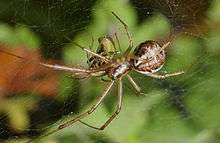Linyphia triangularis
Linyphia triangularis is a European species of spider in the family Linyphiidae first described by Carl Alexander Clerck in his 1758 Svenska Spindlar.
| Linyphia triangularis | |
|---|---|
 | |
| Scientific classification | |
| Kingdom: | |
| Phylum: | |
| Class: | |
| Order: | |
| Family: | |
| Genus: | |
| Species: | L. triangularis |
| Binomial name | |
| Linyphia triangularis | |
Description
Linyphia triangularis grows up to 6 millimetres (0.24 in) long.[1] The carapace is pale brown with darker markins along the edges and down the centre line; the opisthosoma has a coarsely serrate brown band against a white background, with further brown markings along the sides.[1] The legs are greyish brown, and bear many long spines.[1]
Distribution
Linyphia triangularis is abundant throughout Europe.[1] It has been introduced to the U.S. state of Maine, having been first reported there on 28 August 1983 at Stover Corner.[2] It has been recorded from at least 15 of the state's 16 counties,[2] and is now abundant within Acadia National Park and some other coastal parts of the state.[3][4]
Ecology
Linyphia triangularis lives in a wide range of habitats, where it may be found among low bushes and vegetation. It spins a horizontal sheet-web, and rests on the underside of the web for its prey.[5] Adults are active in the late summer and autumn.[1][5] The prey are snared by "barrage lines" above the web, and fall onto the horizontal sheet, where they are killed by L. triangularis, but are not wrapped in silk.[1]
References
- Dick Jones (1983). Country Life Guide to the Spiders of Britain and Europe. Country Life Books. pp. 290–291. ISBN 0-600-35614-0.
- Daniel T. Jennings; Kefyn M. Catley & Frank Graham Jr. (2002). "Linyphia triangularis, a Palearctic spider (Araneae, Linyphiidae) new to North America" (PDF). Journal of Arachnology. 30 (1): 455–460. doi:10.1636/0161-8202(2002)030[0455:ltapsa]2.0.co;2.
- Jeremy D. Houser (2007). The invasion of Linyphia triangularis (Araneae: Linyphiidae) in Maine: ecological and behavioral interactions with native species (Thesis). University of Massachusetts Amherst.
- Jeremy D. Houser; Daniel T. Jennings & Elizabeth M. Jakob (2005). "Predation by Argyrodes trigonum on Linyphia triangularis, an invasive sheet-web weaver in coastal Maine". Journal of Arachnology. 33 (1): 193–195. doi:10.1636/s03-15. JSTOR 3706391.
- D. Marriott. "Summary for Linyphia triangularis (Araneae)". Spider and Harvestman Recording Scheme website. Retrieved September 23, 2013.
External links
- "Linyphia triangularis (arachnid)". Global Invasive Species Database. February 23, 2011.

